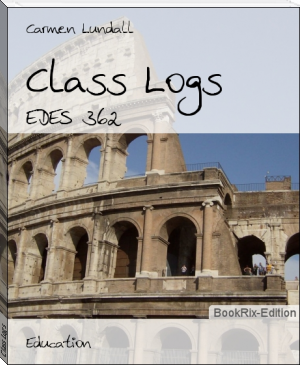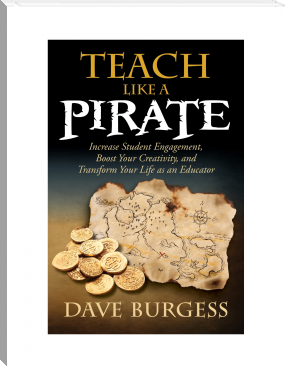Class Logs, Carmen Lundall [e book reader android .TXT] 📗

- Author: Carmen Lundall
Book online «Class Logs, Carmen Lundall [e book reader android .TXT] 📗». Author Carmen Lundall
This book was created as an assignment for EDES 362. As I go through the readings and participate in classroom lectures and discussion, I reflect upon my learning. The image on the front of book has special meaning to me as I remember fondly our family vacation, but also the picture of the Colosseum expresses the greatness and the vastness of learning and building together. We can never forget where we came from or what we have learned and the people who got us there. Just as the Colosseum has different meanings to the people of the world, and for developing who we are as people in this world, so does reflecting on our learning. Never stop learning, never stop reading, and always encourage others to do the same. The picture of the lamp for each page of this book represents my reflections and new ideas that were encouraged and generated throughout this course. I would also like to say thanks. Thank-you Ted for being an amazing instructor and for giving me the confidence to teach Language Arts!
Tuesday September 15, 2009
Language arts is a subject that I always excelled in at school, however, the thought of teaching language arts scares me! As this class carries on I am learning new and different ways that language arts can be taught and taught in way that students find interesting and relevant to their student learning needs. Throughout this class and our first class we’ve received different tools to use in our classrooms to aid in classroom management, brain breaks, checking for understanding, and for those moments when you need to “change it up”.
Today we learned ‘Vote with Your Feet’. I think that this activity is great. The title itself appeals to students and makes them wonder what exactly that means. It’s a great way to check for understanding, while providing students with the opportunity to get out of their desks and move around. I also think that this activity is great to use at the beginning of a class also to get a general understanding of students’ prior knowledge. When you understand what your students already know, you can build on their knowledge throughout the lesson.
Today we also received a simplified version of the program of studies for Grades six, seven, and eight. I found this checklist format extremely helpful and beneficial to my learning, because I can easily visualize all the information and find the format much easier to comprehend and work with. I’ve already used it with ease to plan a language arts lesson, after struggling with the Program of Studies on the Alberta education website.
The readings for today’s class enable me to begin thinking more deeply about language arts, and the need students have to express themselves, whether that be through reading, writing, singing, etc. The numerous developmental stages they are going through require us as teachers to create activities and learning experiences that cater to their specific developmental needs. One thing in particular stood out in my mind regarding young adolescents’ developmental stages and changes as listening to Ted during class, “Understanding your students is key to THEIR success.” Our goal needs to be the children, not the subjects or the curriculum, but how we can reach every student so that they can have opportunities to feel success. The other article that stood out to me during the readings is the one by Frank McCourt. When reading this article, I remembered my personal middle school and high school days and remember hearing my teachers give marks to students “just because”. I knew I didn’t want to be a teacher who felt bad for students and gave them marks because of that; it made me realize how specific and different each child’s needs really are and we have to teach and re-teach until students understand the concepts presented.
Tuesday September 22, 2009
We handed in our “What’s Your Story” assignments today, which we received on the first day of classes. I think this is a great way to introduce yourself to your students and to use the information provided to understand your students and their needs, as well as how their cultural and personal beliefs may affect their learning. Part of creating safe classrooms and knowing your students so that you can meet their learning needs is getting to know your students – this activity is a great way to begin learning about their needs, likes and dislikes.
The silent movie mini-lesson that we did today was very interesting and very valuable. In understanding how we are supposed to present our mini-lesson, Ted modelled for us his own mini-lesson. The silent movie was an interesting way for students to explore their imagination and ability to read people’s emotions. After the mini-lesson was modelled, we began to talk about the importance of teaching students how to write, and the importance of writing in general. Free writing is a great way to open up the door for students to begin writing. During this activity students can be given a topic to write about, or just start writing what is going through their heads. Free writing is great because when students have finished writing their paragraph, you can begin to build on what they have written about. From their thoughts and feelings students can develop a full story, building on what they wrote during their free writing time. There are a number of ways to use free writing in the classroom, and personally I would use this activity in my classroom because it gives students to write down their feelings, and discuss what they think about an issue, if they don’t feel comfortable sharing their answer in front of the class. Other ways I thought were great situations to use free writing include providing your students with a quote or controversial topic to write about, writing a description for a picture or art project, and for those students who prefer not to write, this is an opportunity for them to draw what they are feeling.
Another teaching activity we learned for teaching writing is a response journal. In this instance, you provide students with a topic. The example we used in class was writing about something that has happened in school – the Dawe run. Have students describe through writing what was going on through their minds while they were preparing for the run, what was going on throughout the run, and how they felt when it was over. This also allows students to practice their writing, and you can assess the students writing abilities.
Tuesday September 29, 2009
Today the mini-lessons started and I was introduced to some interesting topics and ideas for presenting language arts and other subjects in my classroom. One of the mini-lessons that stood out to me was Lisa’s. She introduced the idea of bringing drama class into mathematics. I particularly liked this activity because it allows students to understand the vocabulary involved with certain mathematical processes. Students also get to develop their own actions and sounds to help them remember the words and the mathematical process. This activity would be beneficial also in other subjects such as science, or anything that requires a process to solve a problem, or there are rules to using certain processes.
We had a guest speaker today – Joe Bower. He presented some very interesting arguments for language arts and for assessment within language arts. He talked about student portfolios and the need for them as they are more valuable for student learning. Some of the things he talked about make sense, however because I haven’t seen them in practice, it is hard for me to wrap my mind around them. One of the things he spoke about is the importance of getting away from “how” and look more at the “why”. I thought this was interesting because too often we focus on how you do something and when students understand how, we move on, rather than teaching them why things are a certain way. He also emphasized that teaching is NOT the same as learning. Prior to hearing him say this, I knew that teaching and learning are not the same thing, but at the same time it was knew information. I think that personally I sometimes forget that my students don’t learn the same as I do, and they have different needs than I did at their age. We have to continually remind ourselves the number one goal is the students and their learning, not planning the best activities or performance tasks.
We learned the fishbowl activity today, and I think this activity would be great to generate discussion within your classroom, and give students the opportunity to share their thoughts and feelings about a topic or issue, without any pressure to have to go up on their own. I also think it worked really well for discussing the topics covered by our guest speaker. Joe provided us with great resources however I am still not convinces without seeing the theories in practice. I feel that the arguments are very one sided, incorporating one point of view which makes it harder for me to agree. While I see the benefits of the theories and I believe that Joe does see success in his classroom, I am still uncertain as to how I can use this in my classroom, and don`t agree with everything. There are a lot of things that shape learning and responsibility and when I simply hear about these theories, I don`t feel that those needs are being met. I appreciate the time he has taken to come and talk with us, however I need to see to believe in this case.
Tuesday October 6, 2009
Today’s mini-lesson’s were very interesting and I connected fully with Lacey’s lesson. She addressed an issue that it very pertinent in middle schools, but also in the world we live in. She planned a lesson that appealed to me as a college student, but also would engage middle school students. Her hook was very good, and every student would love to have the chance to write about waking up as the opposite sex. I also thought that Mandy’s lesson was highly engaging for middle school students because her objective was getting students to read the images rather than the text. I think this is very important for students to learn this skill because it enables students to read without reading.
To we learned about teaching writing, and how to do this effectively. We looked at Peter Elbow and Joe Bower, and their thoughts on the writing process, evaluating differences and similarities. In doing this we were able to see the parallels in writing – simple assessment, come from within the student (intrinsic motivation), students should be given choices, and that grades undermine learning. While I agree with many of these points, I find it very hard to assess without putting a grade on the piece of work. Call me traditional, but that’s how I grew up being assessed, and I have trouble fully understanding why a number is different than a letter – they still hold value to the student and they still know that if





Comments (0)